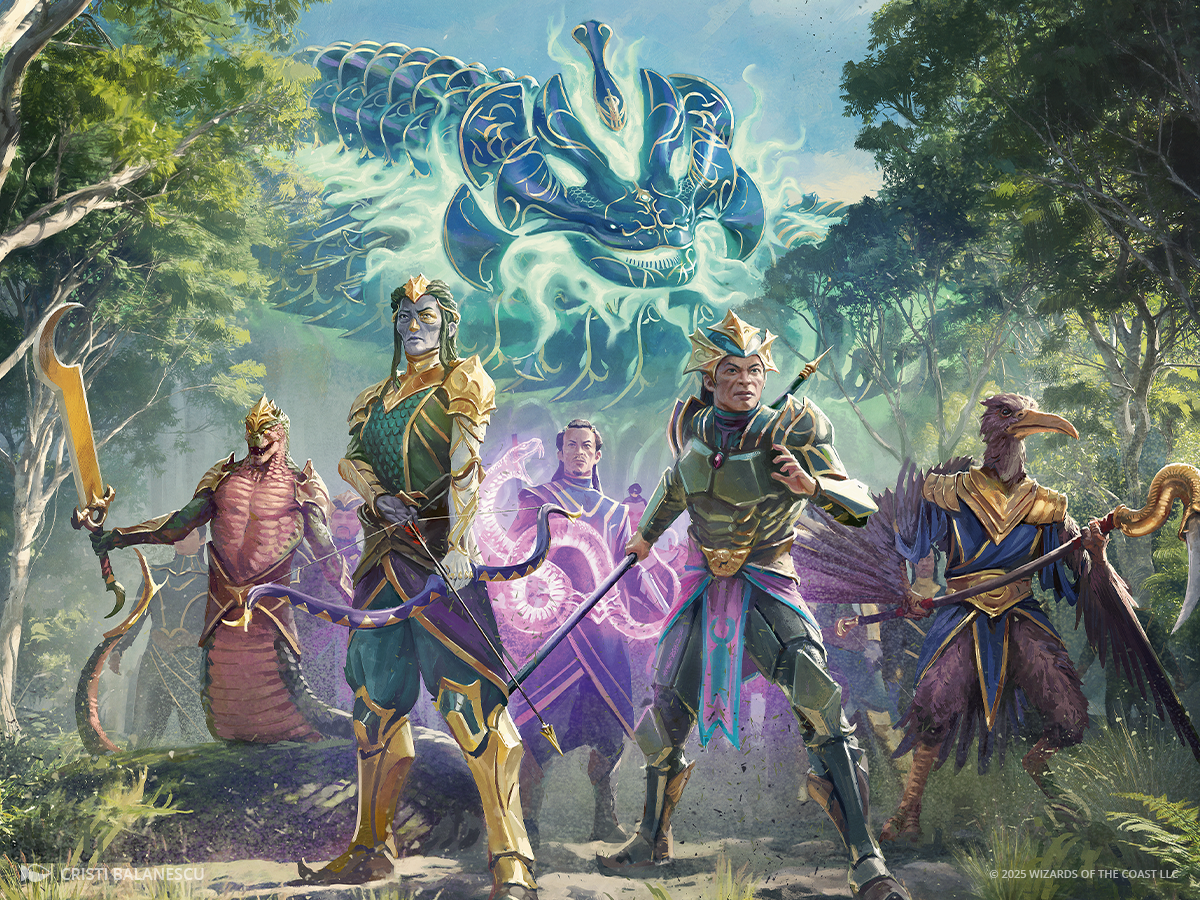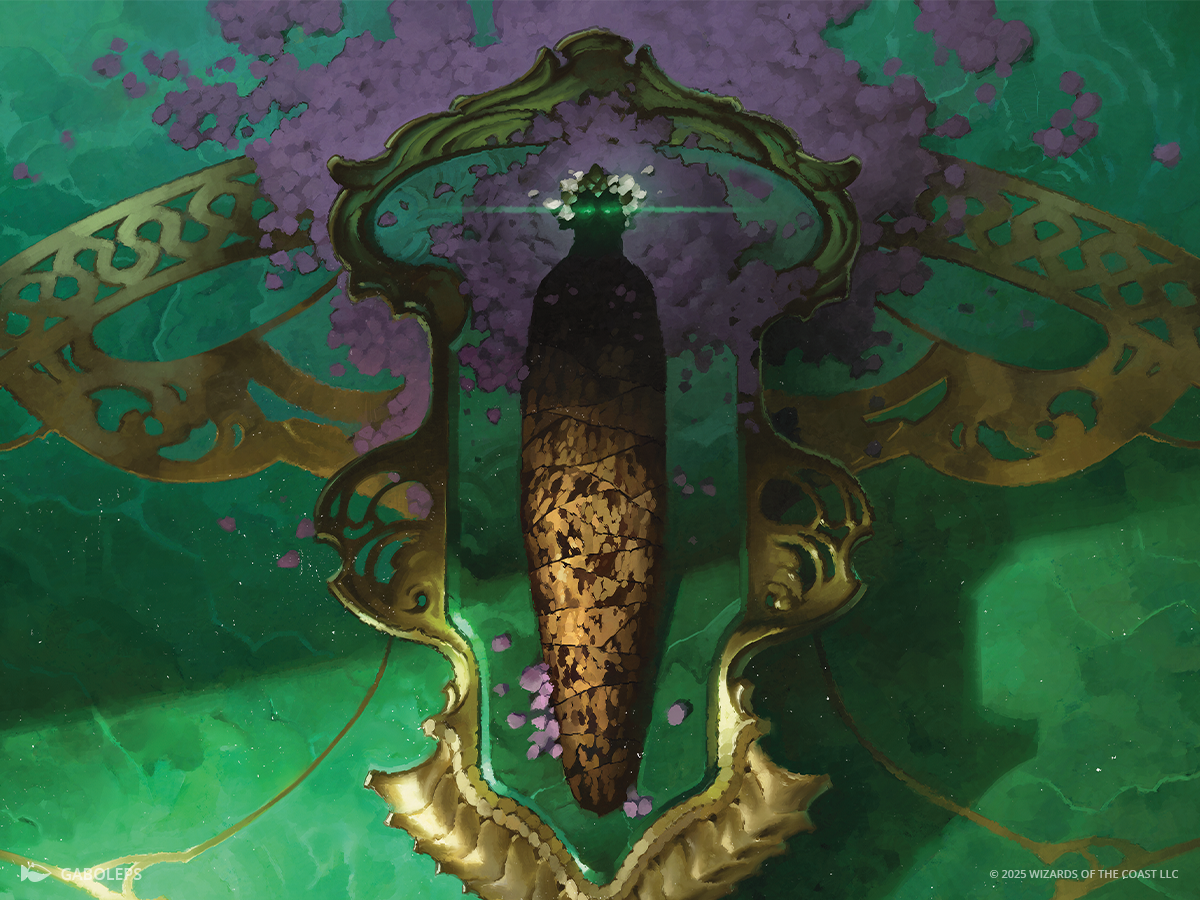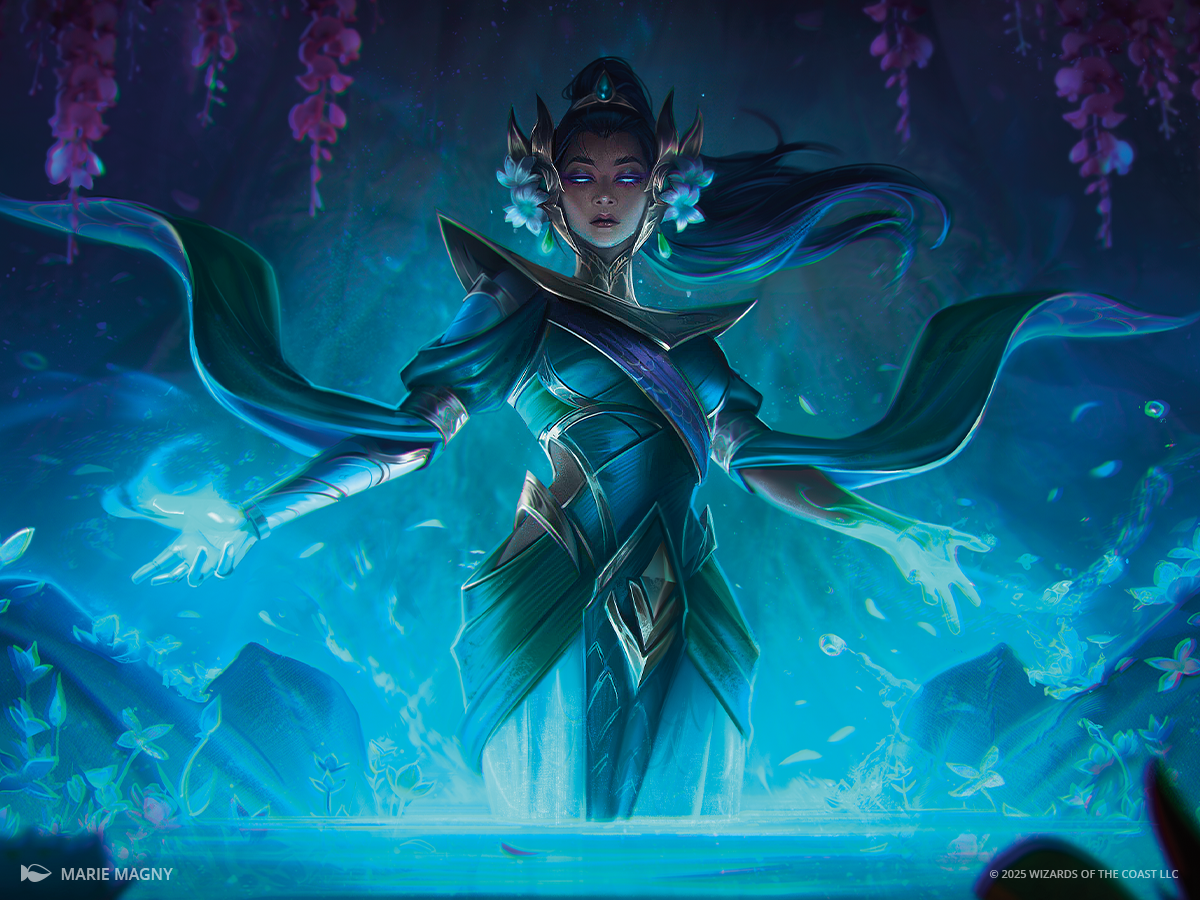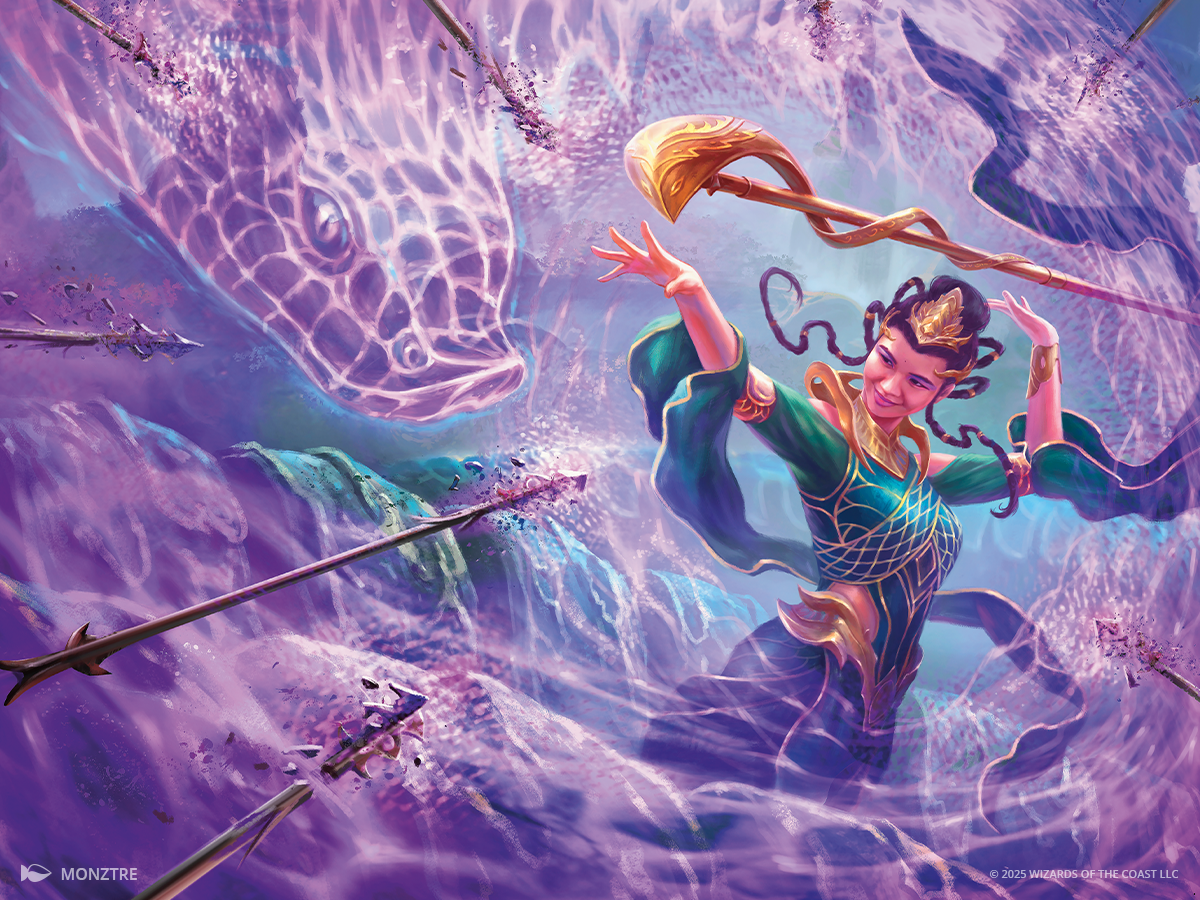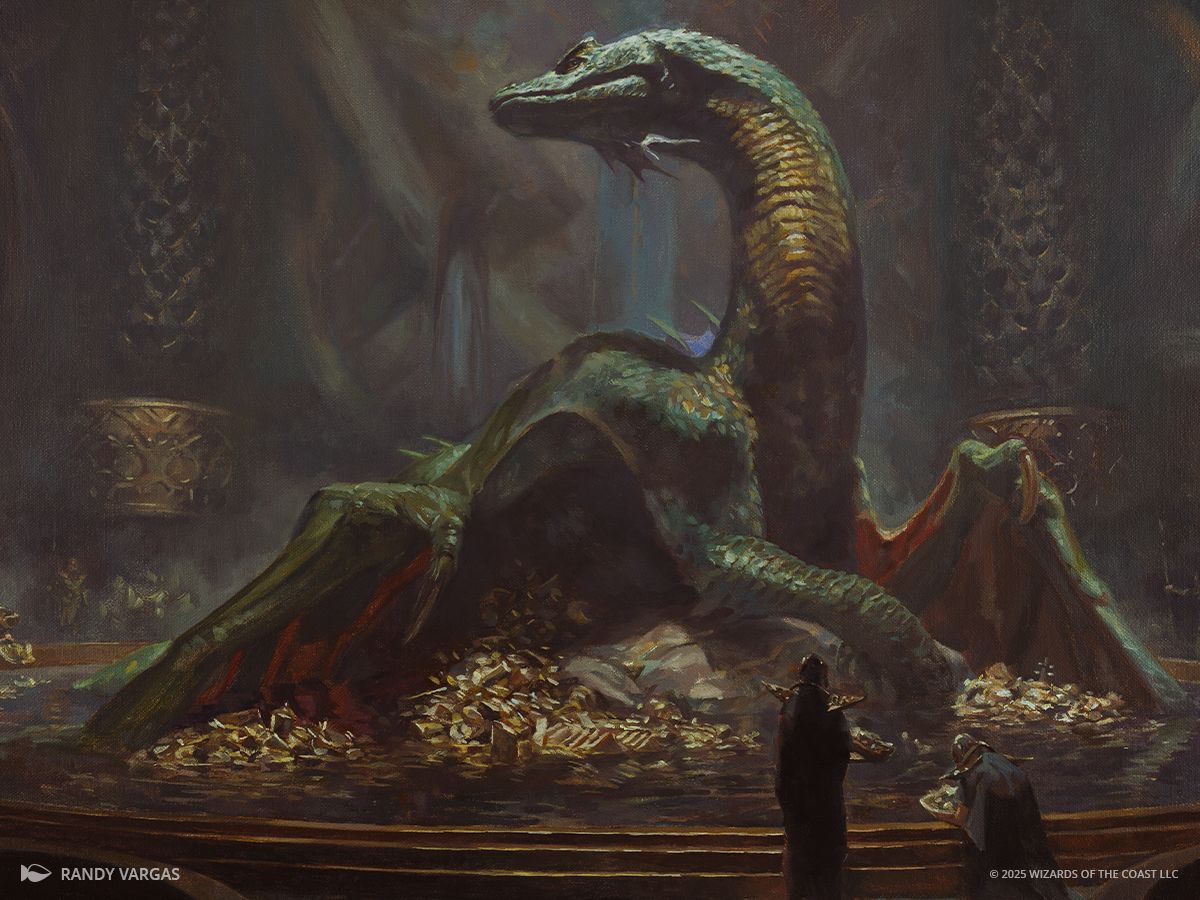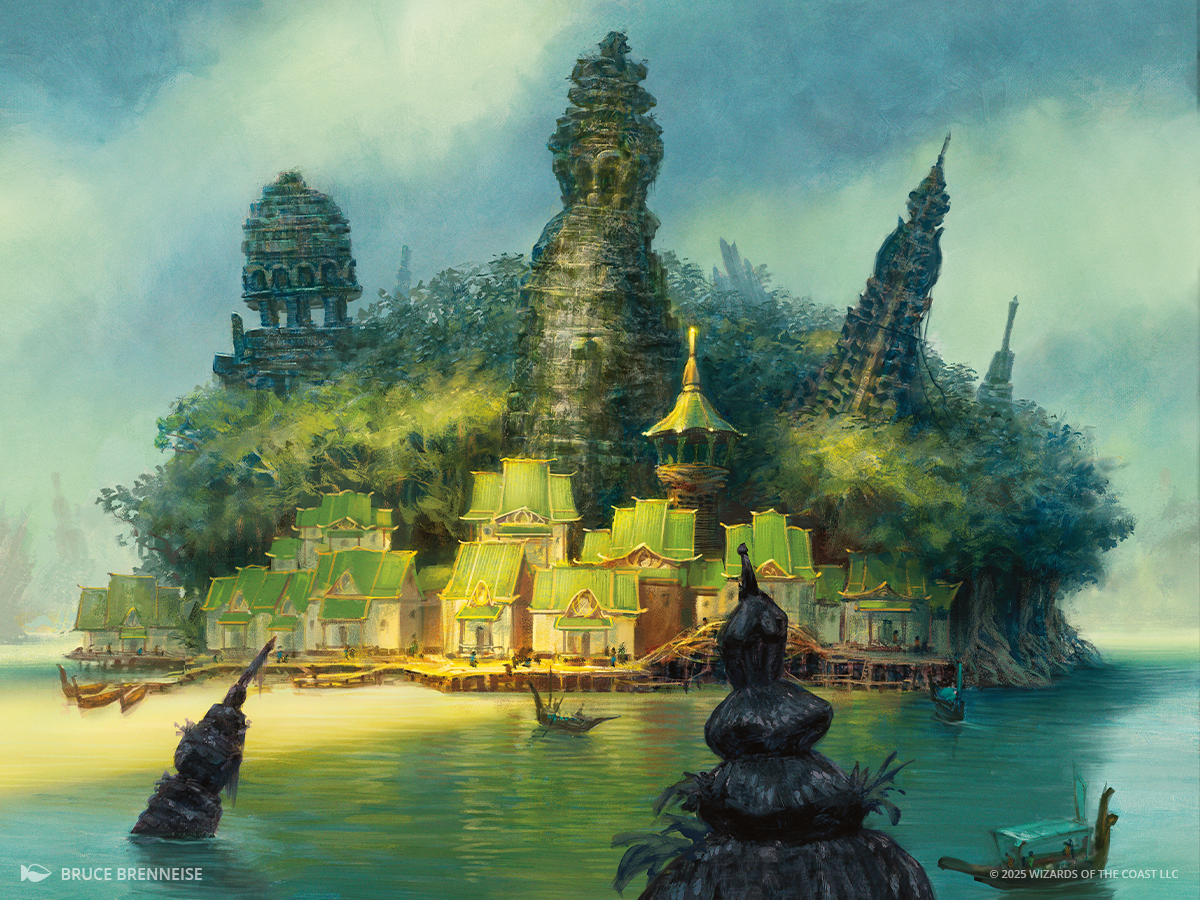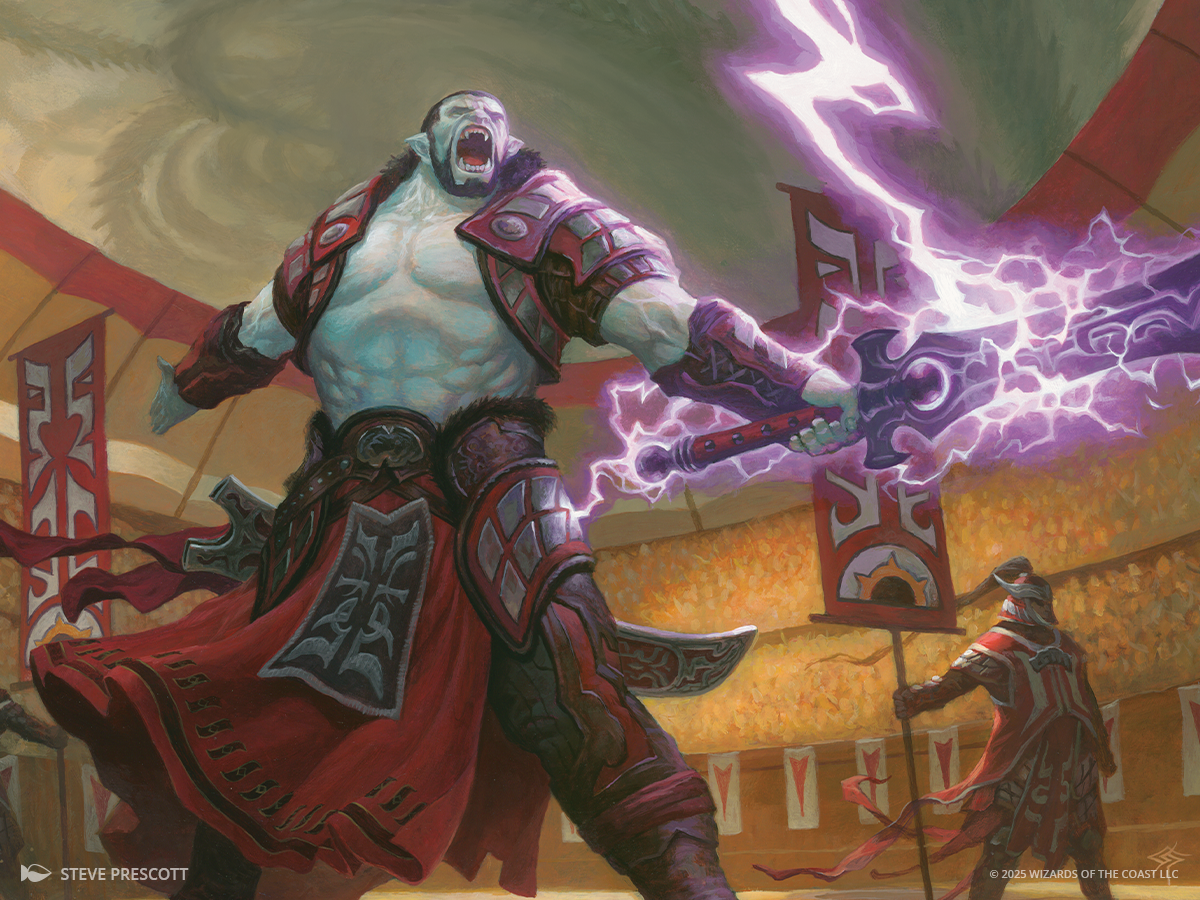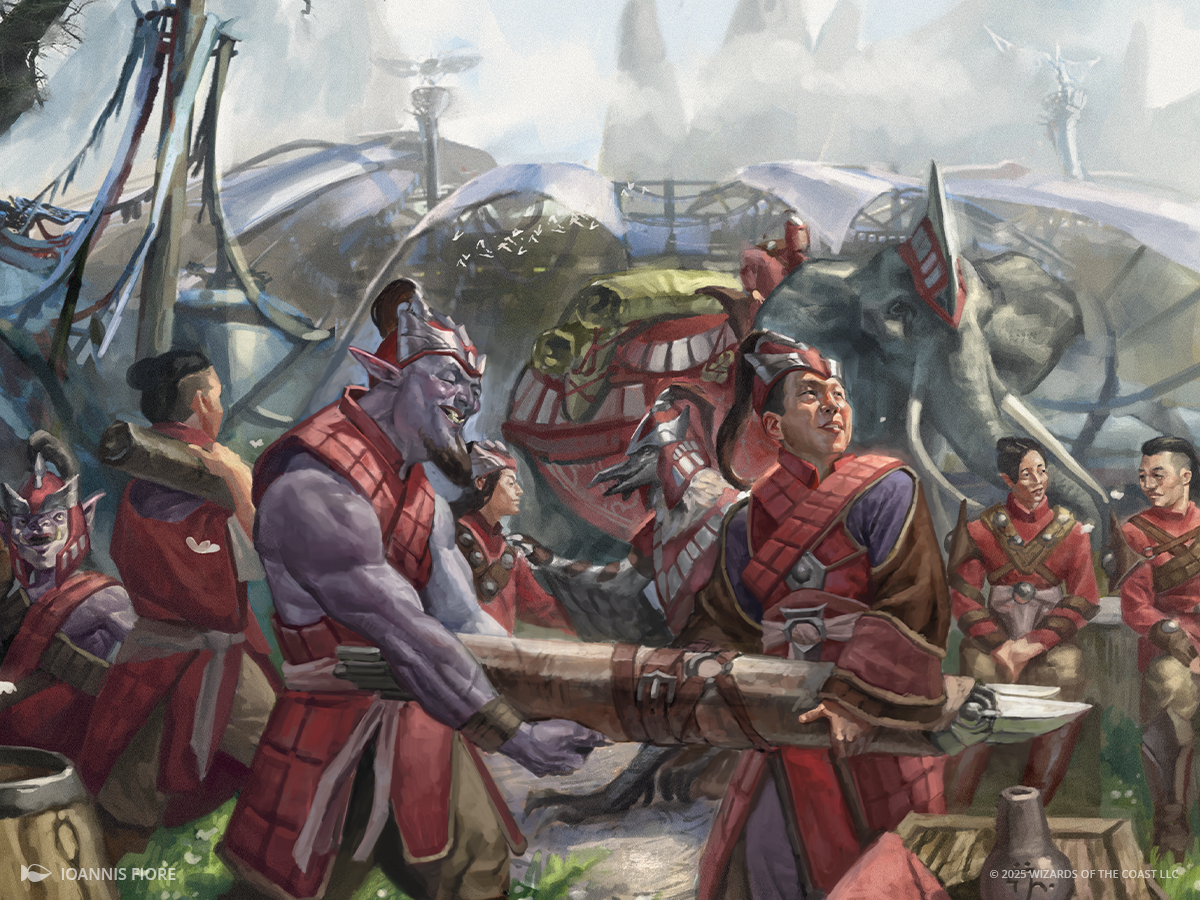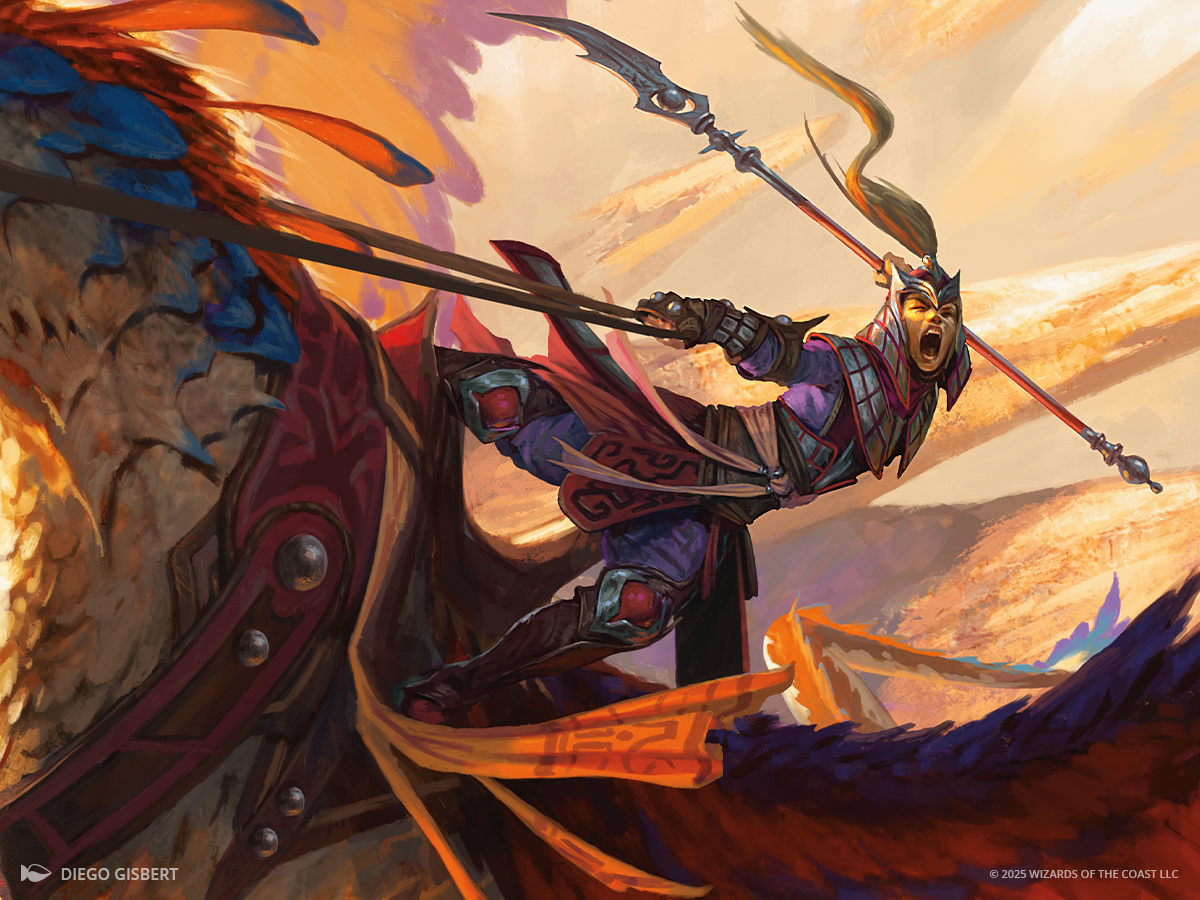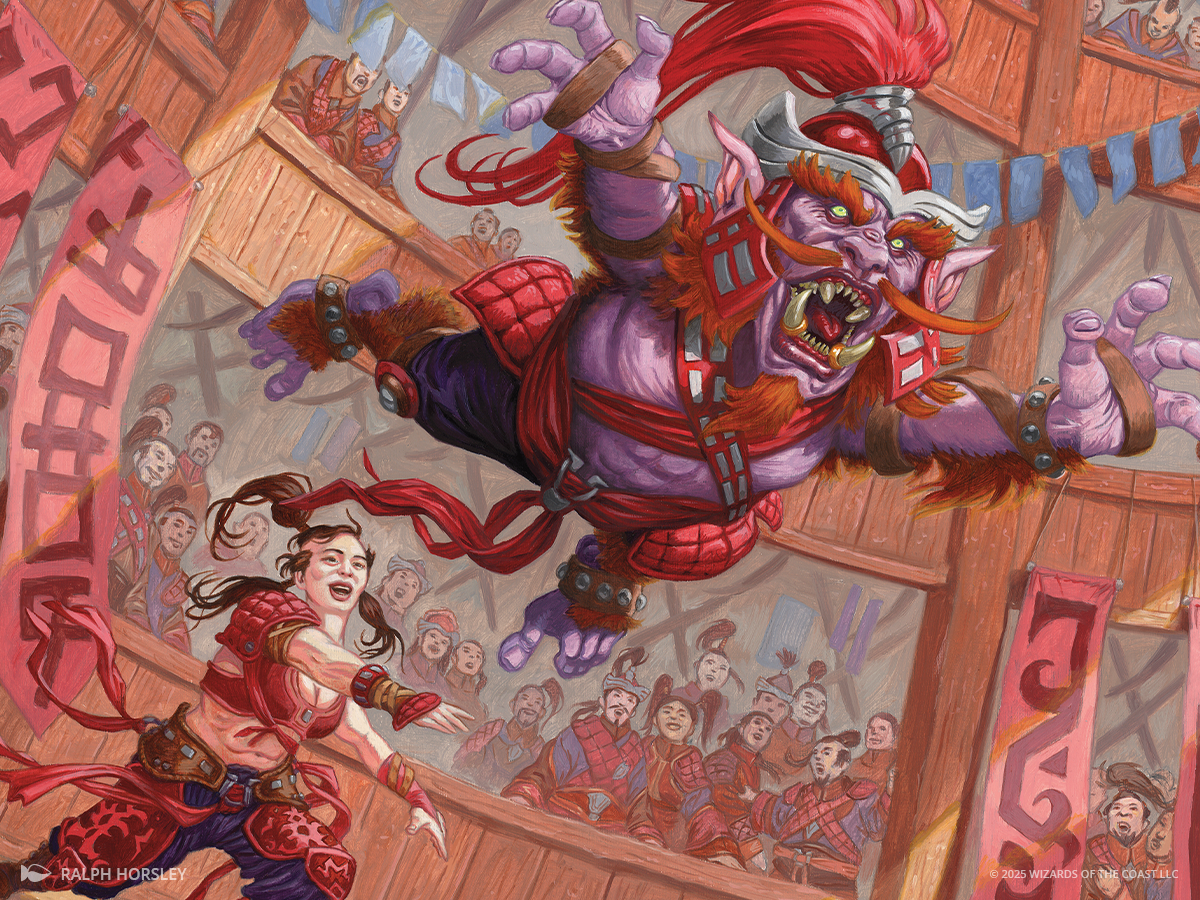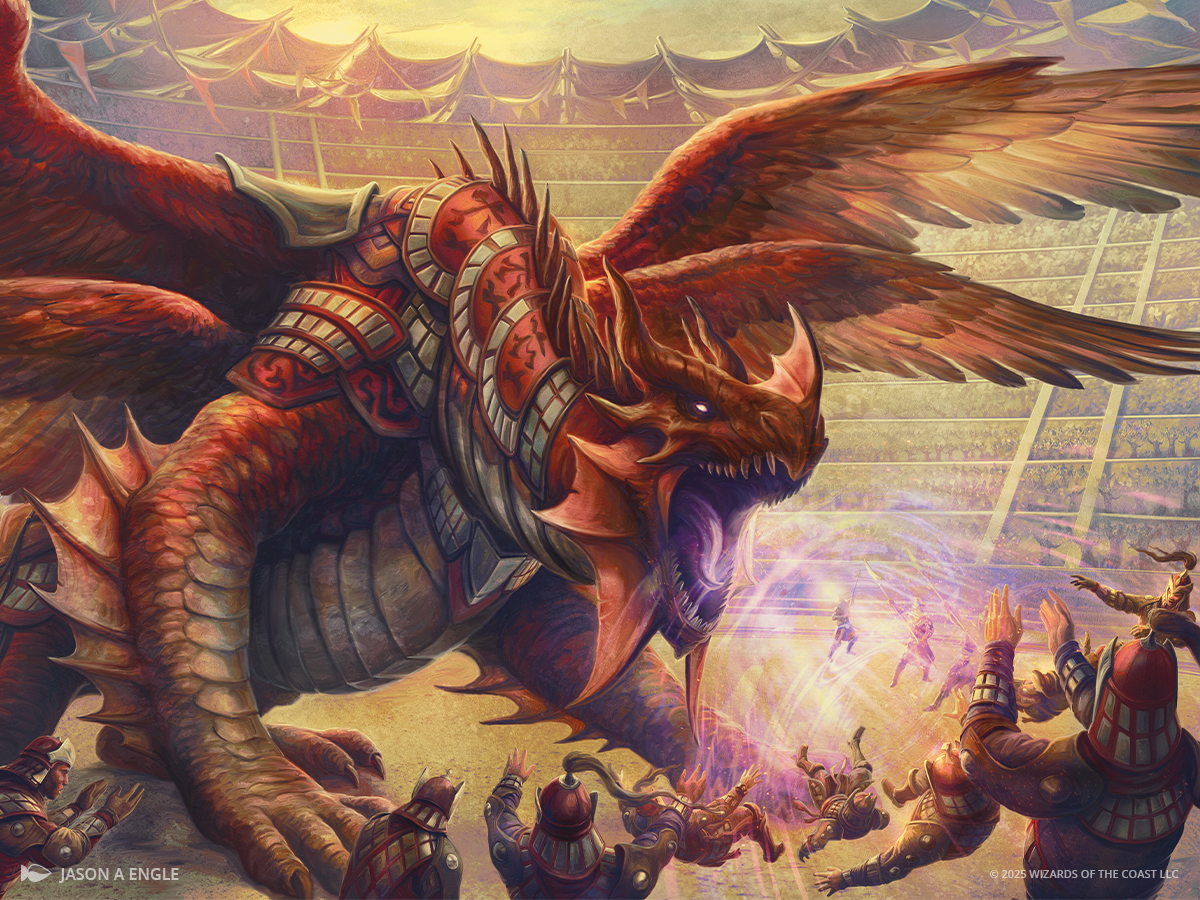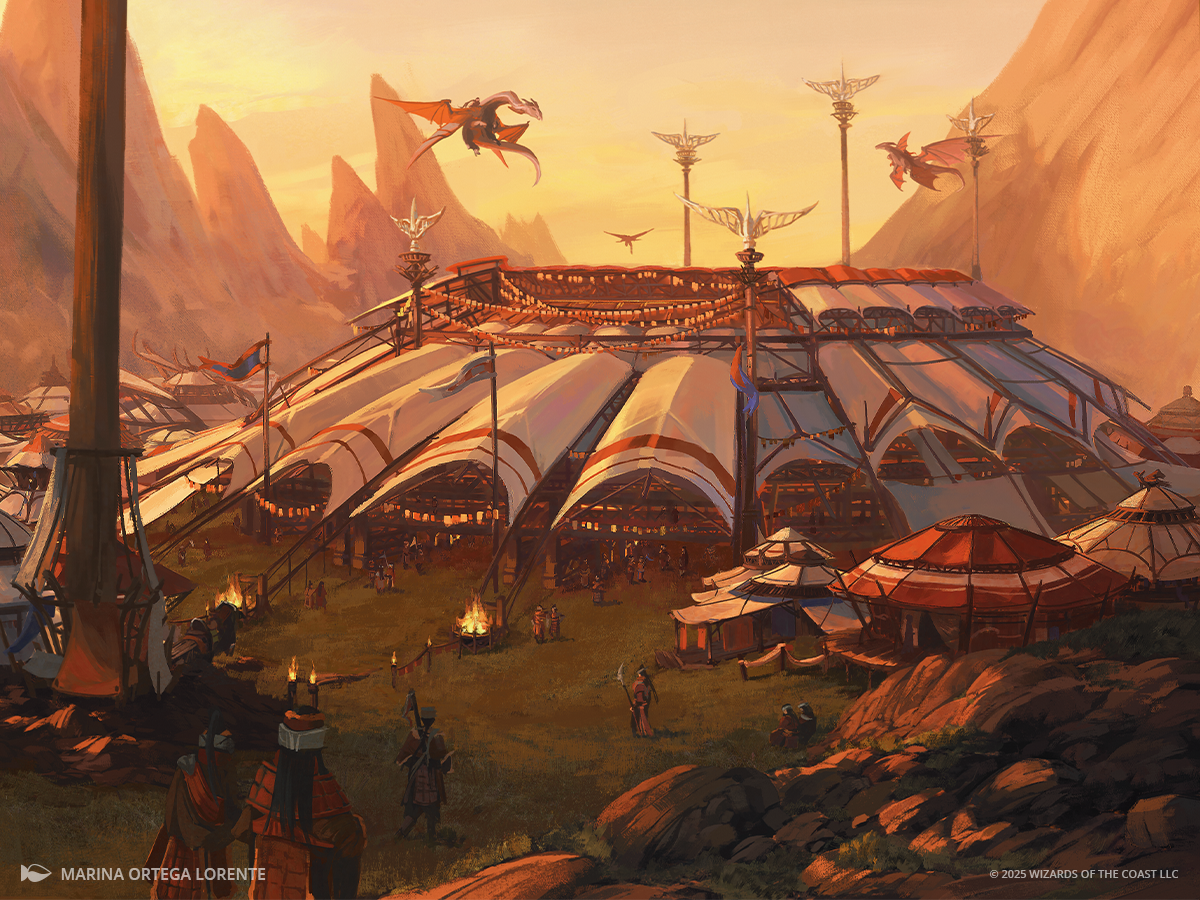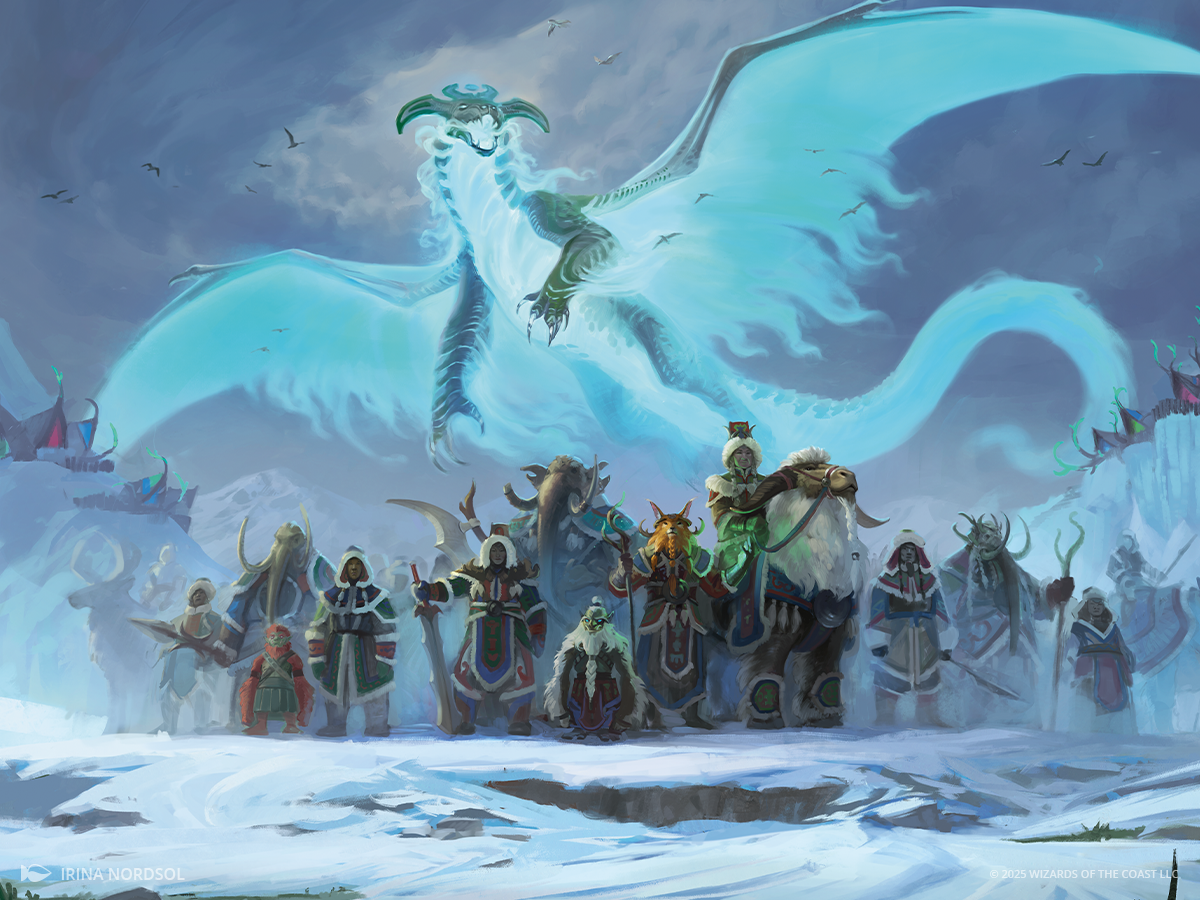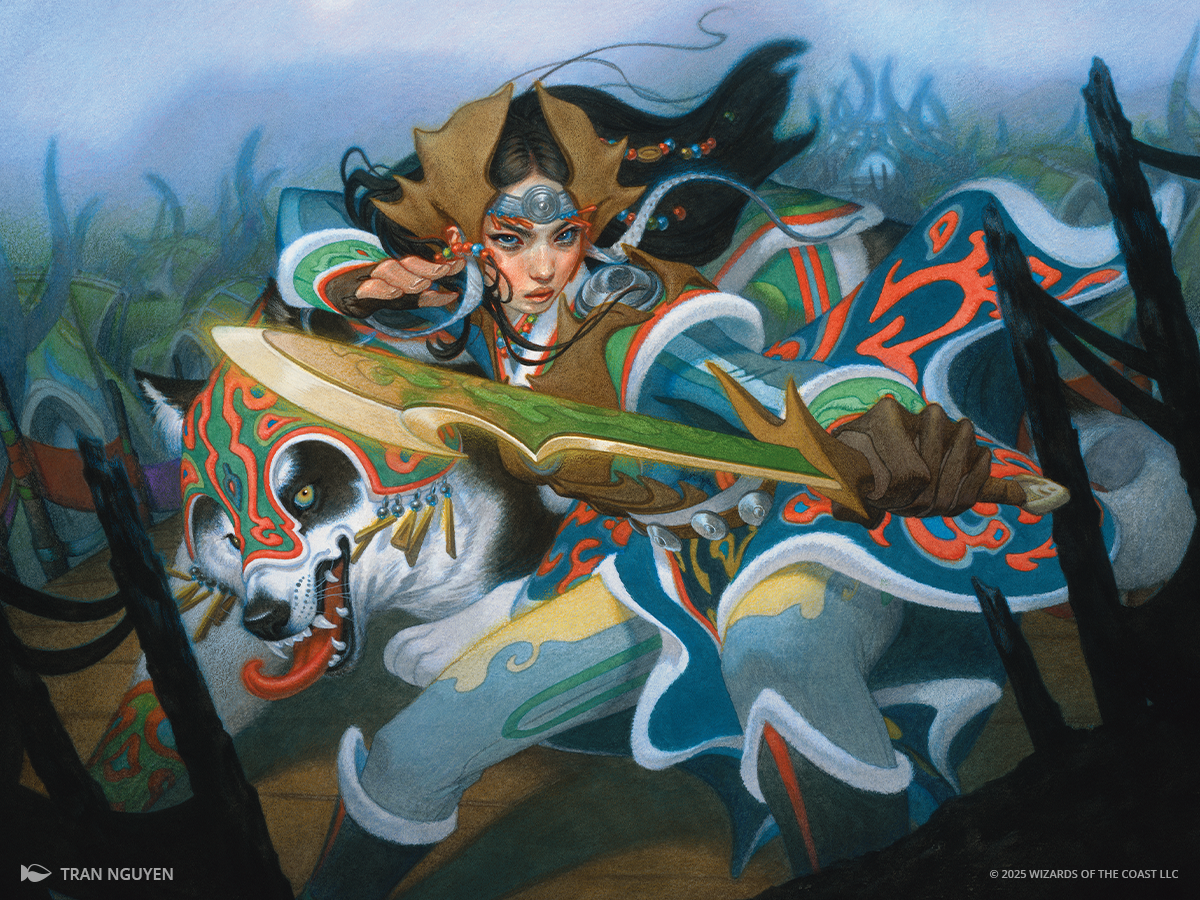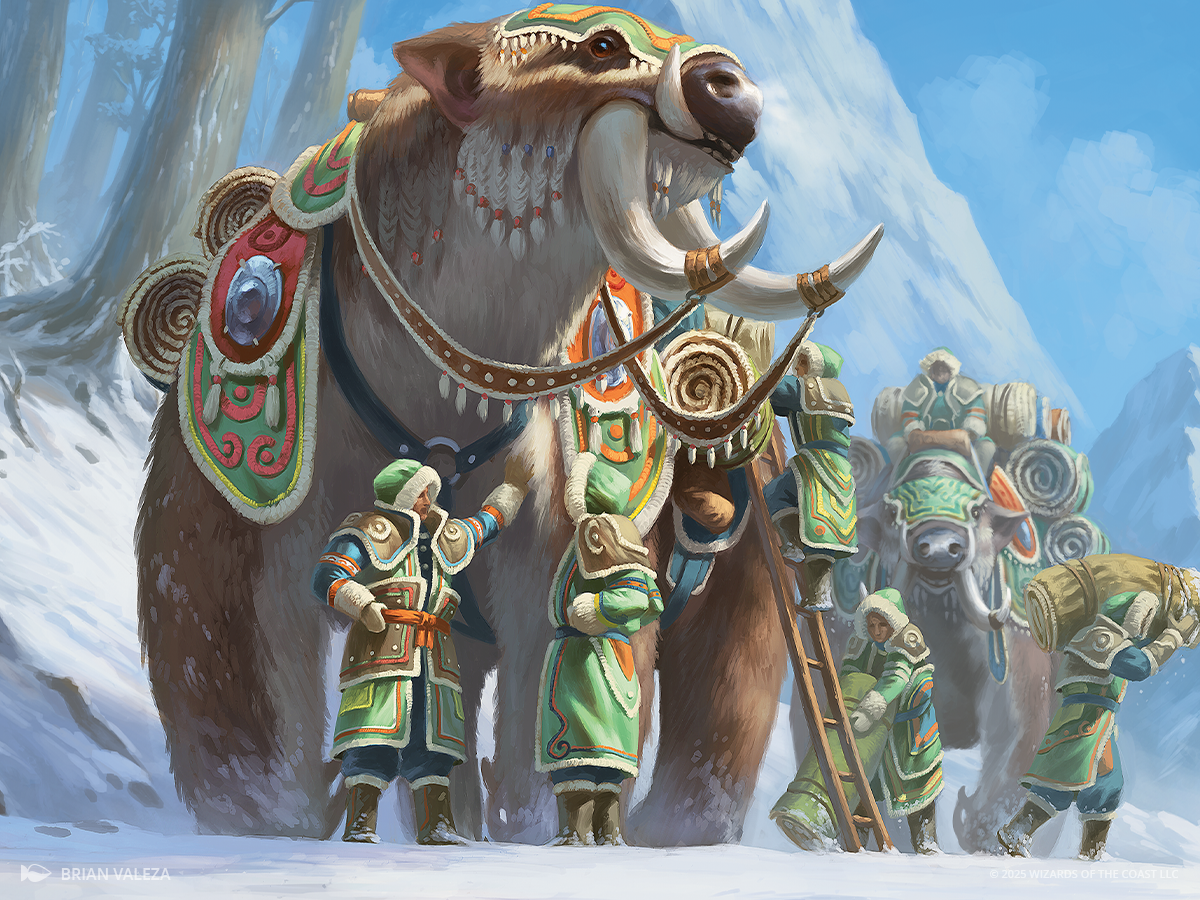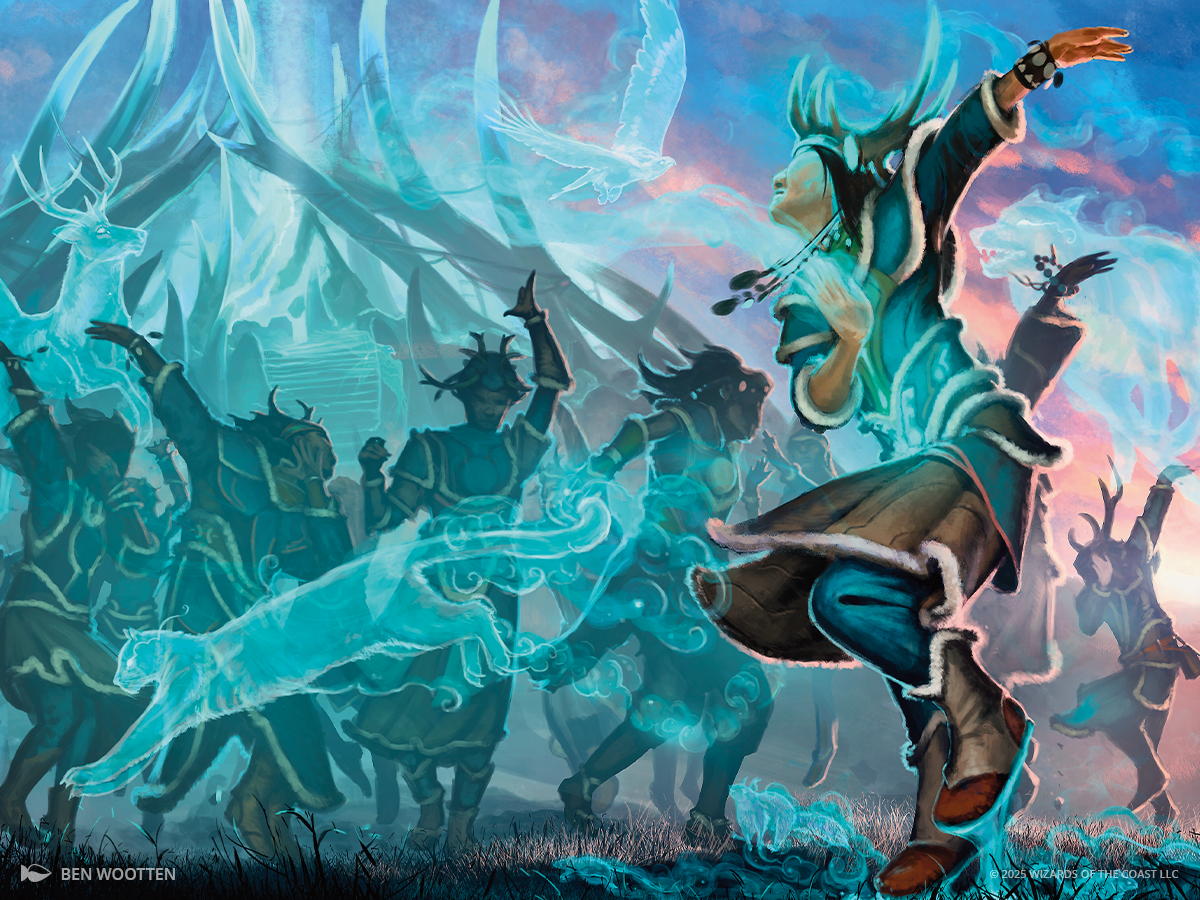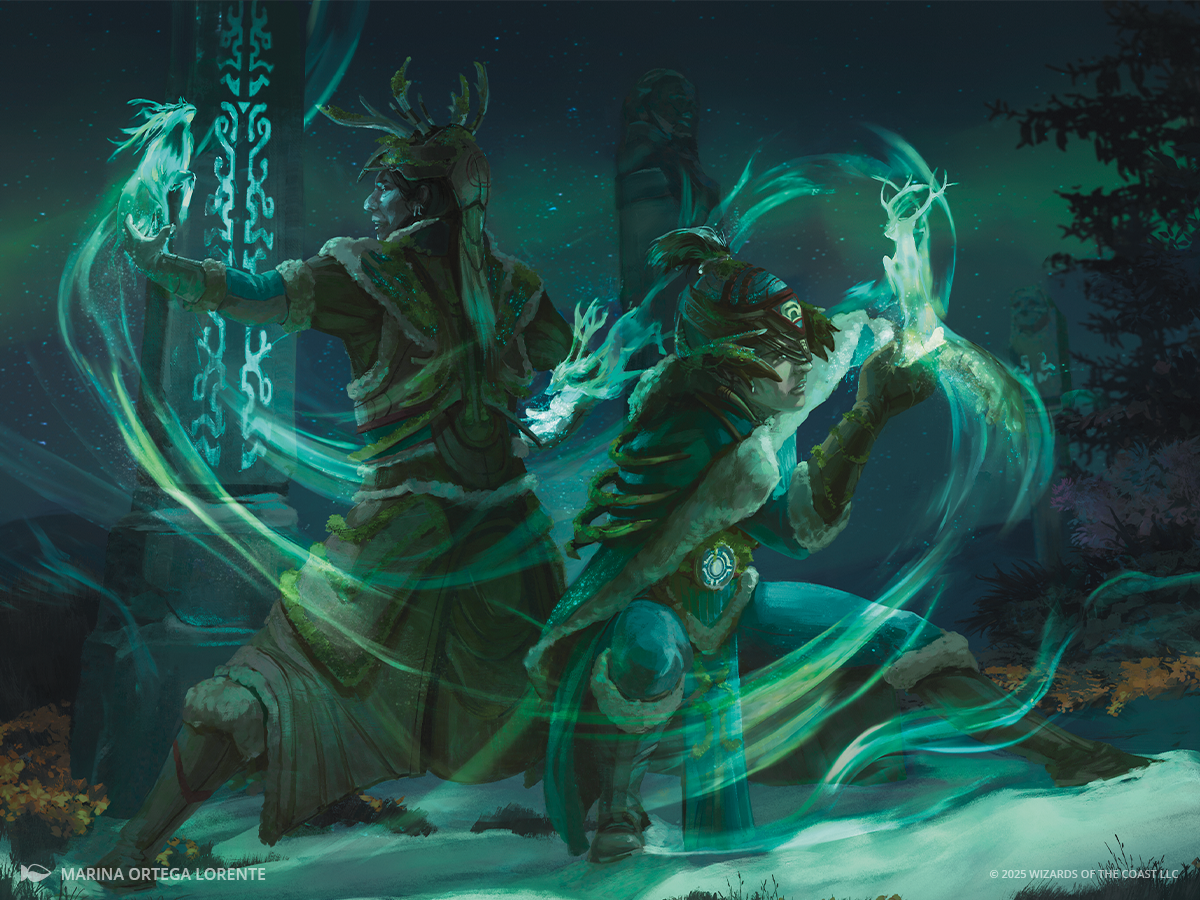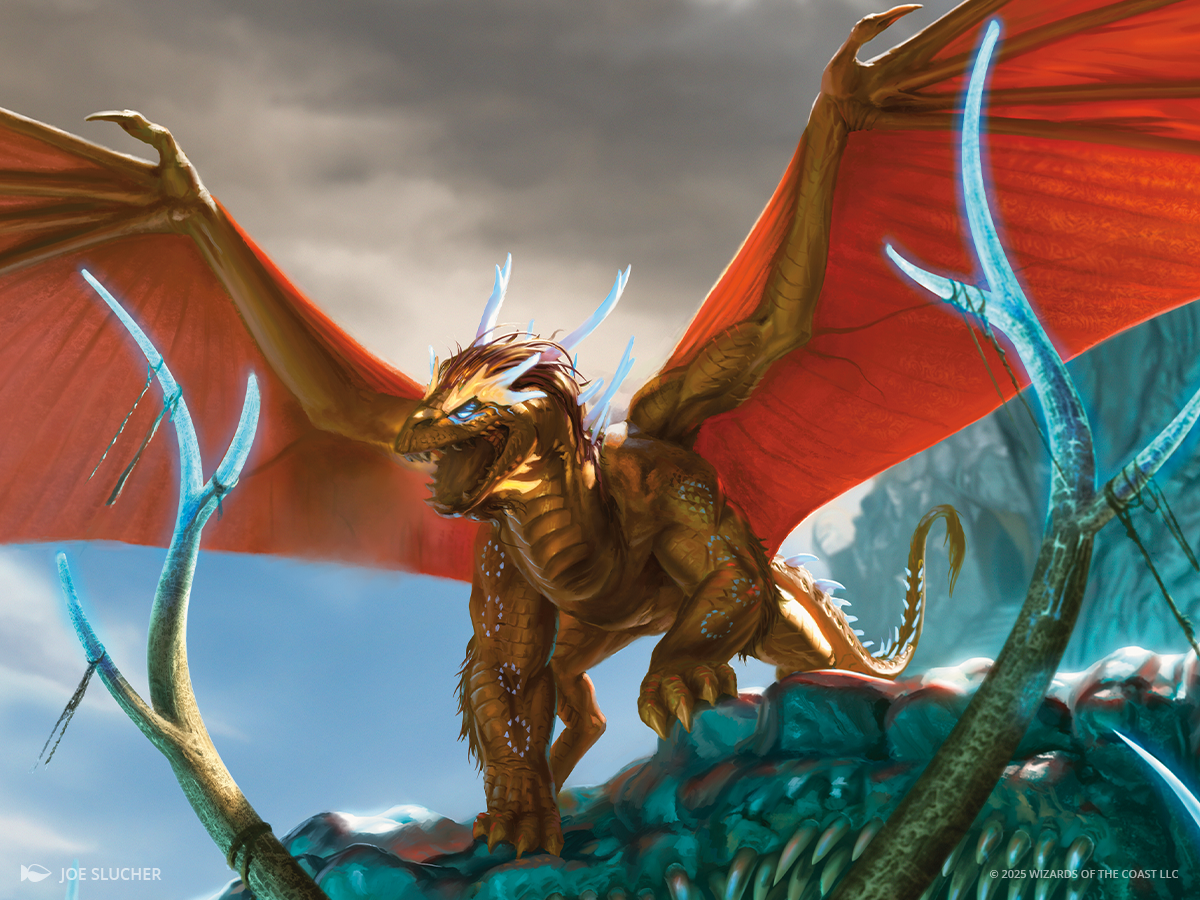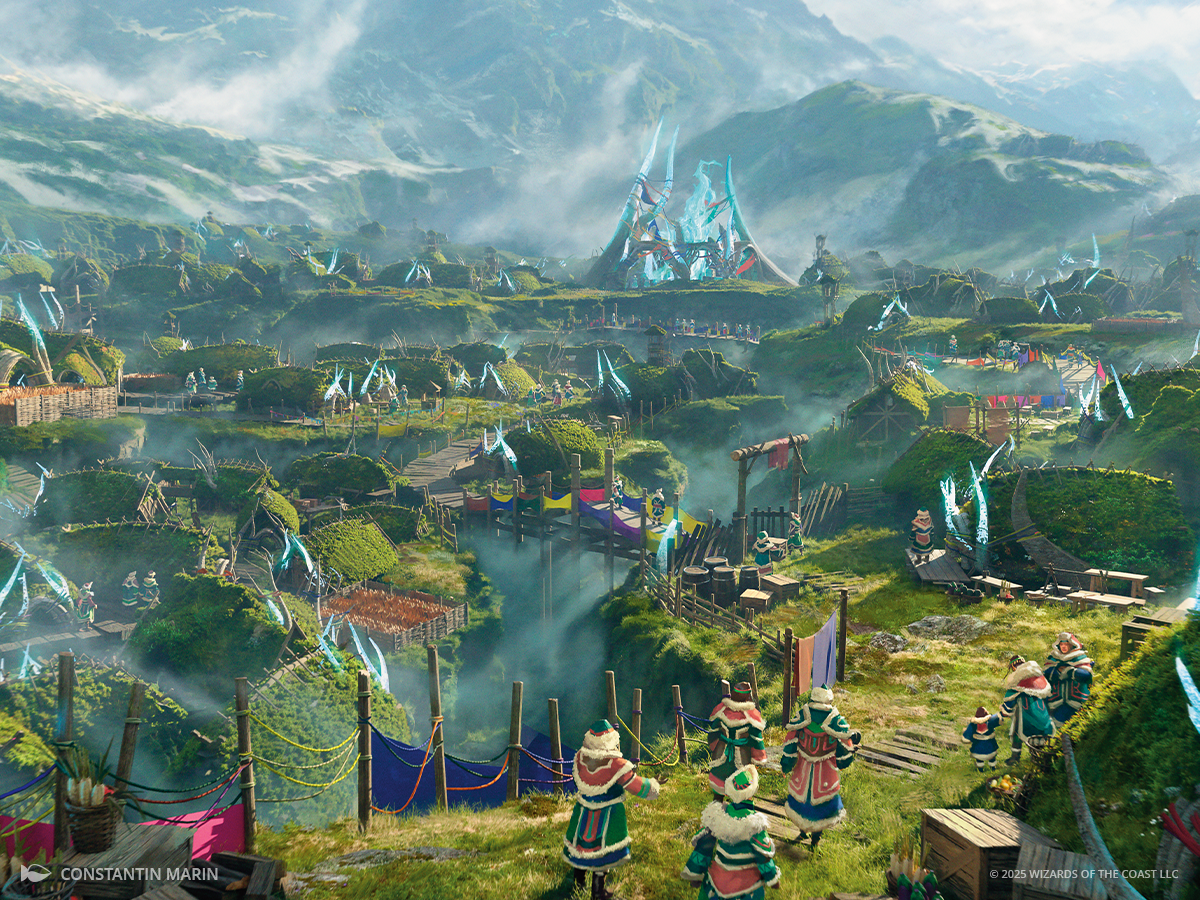Planeswalker's Guide to Tarkir: Dragonstorm, Part 2
In Tarkir: Dragonstorm, dragons take flight and clans do battle across one of Magic's most iconic planes. We're giving you an early look at this set with the Planeswalker's Guide to Tarkir: Dragonstorm. This is part two of a two-part series. You can read the first part here and catch up on the card previews in Collecting Tarkir: Dragonstorm – A First Look.
The future of Tarkir hangs in the balance, and you'll be among the first to see what happens when Tarkir: Dragonstorm's story releases on March 3, with audiobooks available on The Magic Story Podcast!
Discover what lies at the heart of this storm when Tarkir: Dragonstorm releases on April 11, 2025. The set is available for preorder now from local game store, online retailers like Amazon, and elsewhere Magic products are sold. Join your clan and break the storm!
Table of Contents, Part 2
The Sultai 
"Nothing goes to waste."
Living in the jungles of Tarkir, the Sultai are adept at transforming challenge into opportunity. They expertly cultivate the land around them, transforming the sprawling jungles into efficient farms and building exquisite cities amidst the dangers of the landscape. In the Sultai, not even death can stop the most valuable members of the clan, as their powerful necromancers raise their honored dead to continue to lead and serve. The small but elite forces of Sultai warriors leverage stealth, terrain knowledge, and espionage to outwit their enemies, maintaining the clan's position and power within the plane.
The abundance of fertile ground and the expertise of Sultai agriculturalists make the clan's food and materials wildly desired across the plane. The Sultai use trade and diplomacy to their advantage: maintaining an outwardly positive relationship allows for more subtle forms of subterfuge to strengthen their power and position among the clans. Their vast network of spies and scouts track the activities of the other clans to help the Sultai determine their next moves. While the highly specialized soldiers of the Sultai use meticulous planning and the terrain to their advantage in conflicts.
Revival of the Sultai
For the humanoids of Silumgar's brood, life was perilous, their worth measured at the whim of the capricious dragonlord. Anger and discontent were fomented among the general population. Though the dragonlord easily put down the small rebellions, the roots of resistance flourished. The rebels saw the leadership of Silumgar and the past Sultai as a continuation of the same oppression: wasteful, decadent, and cruel, they hoarded wealth and destroyed the natural resources of the jungle while ignoring the suffering of the people.
The rebellion leaders invoked the name of the Sultai as a rallying cry and looked to the clan's origins from before the demonic pacts. In the aftermath of the Phyrexian invasion, the humanoid rebellion was able to gain ground, claiming Silumgar territory as their own. Their powerful mages, many trained by dissenting naga, leveraged necromancy to bring their warriors and leaders back from the dead to bolster their small numbers. These undead were given a place of honor and authority, their knowledge and expertise too valuable to be lost to death. Their empowered forces led to Silumgar's defeat alongside the other dragonlords.
Sultai Society
After the previous draconic leadership, many Sultai are hesitant to follow a singular leader, as a result, power within the Sultai is largely decentralized. The Fangkeeper is considered the ruler of the Sultai but takes on a minor role in day-to-day life. Their primary responsibilities involve the management of relationships between Sultai villages, acting as a more impartial judge alongside the spirit dragon, and managing the standing army of the Sultai and its defenses against the other clans. Within each village, elected mayors make most decisions alongside a lead necromancer priest who commands respect from the community.
Compared with other clans, the Sultai maintain a smaller standing military force, the Lasyd. They are highly trained and skilled warriors, experts at fighting in the dense terrain of the jungle and using their adaptability to outmaneuver the larger and less flexible forces of other clans. Also within the ranks of the Lasyd are spies, scouts, and assassins who move nimbly throughout the plane to ensure the safety and security of the Sultai.
Naga are some of the most powerful magic users on the plane, and they are experts at wielding and manipulating life essence to harm and to help. Many villages within the Sultai have a naga protector; separate from the mayor or lead necromancer, they guard the village and surrounding region from threats both within and outside of the clans, passing judgment and punishment in the form of blessings or curses.
Rakshasa demons are shunned in Sultai society, and those who make pacts with these demons are exiled or killed. Rakshasa are considered enablers of the cruelty and exploitation of Silumgar and the old Sultai, and they're hated for their role in the great traitor Tasigur's betrayal of the ancient Sultai.
Daily Life
Civilians within the Sultai live primarily agrarian lifestyles. Many are farmers and fishers who sustain the clan and provide goods for export. Artists and craftspeople are also highly respected within the clan, including shipwrights, weavers, and smiths. A small but powerful merchant class, the Panjasi, sell these goods and materials to other clans and often act as spies as part of the larger Sultai information network.
- Agriculture and farming – Both are central to the day-to-day life of many Sultai citizens, their years and days dictated by the growing seasons and needs of crops. The Sultai are known for their pursuit of beauty and elegance within horticulture, breeding animals and plants for their aesthetics, such as albino reptiles, bright-plumed birds, and plants of extreme size. Additionally, they build beautiful gardens and landscapes within their villages.
- Arts and handcrafts – The Sultai place high value on ordered beauty, and many artistic pursuits are common within the Sultai, such as silverwork, goldsmithing, and crafting exquisite jewelry and other adornments. The Sultai are also highly skilled at textile weaving and dying, producing vivid silks and cottons coveted by other clans. On a larger scale, their artisans create huge, dramatic, and elaborate stone sculptures to adorn their cities.
- Lotus dance – The Sultai also have accomplished dancers, highlighting the elegance and grace of the Sultai way of life. Large-scale performances are popular forms of entertainment, and dance is often incorporated into harvest festivals.
- Dusan boxing – A variety of sports are communal pastimes for the Sultai. Friendly competitions are used as an outlet for individuals' ambition and competitiveness, including the popular Dusan boxing; most commonly, matches consist of a one-on-one fight without weapons where both individuals have rope wrapped around their fists and forearms.
The Abiding Harvest
The Abiding Harvest is the core belief of the Sultai: All living things die. Their essence nourishes the land and enables the next harvest. After death, a person's life energy is returned to the larger pool of life force in the earth and returns as new life. For the Sultai, this is not believed to be the exact same person or consciousness returning but rather an essence or energy of a person. Like water mixing into a larger pool and being poured out, no two cups of water will be the same, and the pool must be constantly refilled, or it will run dry.
Rite of Renewal
Raising of the dead is done through the sacred Rite of Renewal. The offering of the deceased is typically done by next of kin or through a will made in life that denotes they should be offered. Under the old regime, raising a person as sibsig had been used as a form of punishment to garner the loyalty of the masses through fear and intimidation. The new Sultai view this practice as symbolic of the cruel and wasteful decadence of the ruling classes and have outlawed the raising of unwilling individuals. Beloved leaders, skilled artisans, and venerated warriors are the most common people to be returned. Being returned is now viewed as an honor and is a fate many covet as a symbol of their value to the larger Sultai community.
The ritual starts with preparation of the corpse, a meticulous and delicate process involving necromantic magic, alongside specially prepared poultices and serums. The corpse is repaired if needed, fine prosthetics are made to replace limbs, wounds are sewn up, and other decorative elements may be added. The corpse is then dressed in ritual garments and placed on a raft that floats in a bath within the temple. The priests will then use necromantic magic to draw energy back into the body, returning the body to life. However, not all who are offered are successfully returned through the ritual. In these instances, it is believed the individual's energy needed to remain in the land.
Animals may also be raised by necromancers and are given similar respectful treatment. Some exceptions are made for self-preservation: a necromancer is allowed to quickly raise a non-sentient creature for their defense.
Sultai undead are referred to as sibsig and have an honored status within the clan. The returned sibsig retain a sense of self and memories of their life before return, but there remains some question if they are wholly the same person. Most sibsig will still consider themselves the same individual and continue in the same role, often with an elevated status. Though there are examples of returned individuals having different personalities from whom they were in life or having memories that do not seem to be their own, some may pursue entirely different roles within the Sultai after their return.
Funeral and Burial Practices
Funerals are elaborate and festive; a celebration of the life lived is necessary to process grief and let the person's essence return to the earth. Common activities include preparing a feast of the deceased's favorite foods and a "gifting" where the worldly possessions of the deceased are given out according to their will.
Proper burial is very important among the Sultai. The process is intended to facilitate the deceased's body and energy returning to the land and completing the cycle of life and death quickly and efficiently. Bodies not being returned, as sibsig are minimally prepared: wrapped in cloth, they are buried without possessions (of which they have no need) in shallow watery marshes. There, the bodies quickly decompose and the water is used to irrigate the abundant Sultai farmland. Specialized priests will watch over these grave-sites, weaving necromantic magic to ensure the bodies decompose properly.
After someone's passing, friends and family members will often carry a possession of the deceased on them for a full harvest season. This is a reminder of their passing and aids in their energy returning to the cycle.
Seasonal Celebrations
The mild year-round climate and highly organized agricultural system mean the Sultai have two annual harvest and planting seasons staggered from each other, the Spring Rotation and the Fall Rotation. The combined harvest and planting event is a highly anticipated clan-wide activity, marked by a religious festival. The rotations often include large feasts with various performances and a ritual ceremony performed by a priest to ensure a good growing season.
Sultai Magic
Sultai magic primarily revolves around the manipulation of life essence, using it to weaken or strengthen, to heal or harm, as desired by the wielder. Magic users are also adept at divination, through speaking with the essence of the dead and interaction with remains. Most mages undergo formal training under the most skilled necromancer in their village. Particularly promising mages may travel to the Kheru City to train under the most powerful of the Sultai, including naga teachers.
The Sultai's Relationship to Dragons and Dragonstorms
Dragon Hunts
The Sultai maintain a wide network of spies and scouts who relay information to aid the clan in predicting the timing and location of the next dragonstorms. Many scouts are trained to observe subtle changes in weather that indicate storms approaching, while others spy on the activities of the clans to predict their movements. When capturing wild dragons, the Sultai will often arrive in much smaller numbers than the other clans and wait for another clan to subdue the dragon before launching an ambush to pick off the now weakened forces and take the dragon for themselves.
Clan Dragons
Designated warriors and mages care for most dragons. Many participate in religious festivals and act as guardians of villages alongside the naga. They tend to select Sultai dragons for their lithe and adaptable builds, allowing them to live in the dense jungles where prolonged flight can often be challenging. Sultai dragons tend to be skillful ambush hunters. The Sultai select some dragons purely for their beauty and grace, though that does not stop them from being just as deadly. Sultai dragons wield a noxious poison-breath weapon that envelops their enemies and often suffocates them before they die from the toxins.
Dragonstorms
The dragonstorms have resulted in rising water levels throughout the Sultai territory. They have leveraged this to their advantage, building raised cities on stilts over flooded ruins, letting nothing go to waste. Sultai mages will also adapt the jungle to the storms, manipulating plant life to direct the rains, watering crops and protecting homes.
Locations
The majority of Sultai territory is in a massive river delta, located in the south of the continent. Sultai territory directly borders that of the Mardu, Abzan, and Jeskai clans. The climate of the Sultai territory is primarily tropical, humid, and warm almost all year round with larger storms in the winter.
- Kheru City – The central city of the Sultai, Kheru was built around what was once the Kheru temple complex and is located within the waterways of the river delta. A beautiful city of large stone buildings, bustling markets, warrior practice grounds, and schools for magical training.
- Qarsi Palace – Located in Kheru City, the palace has been repurposed since Silumgar's rule to be the center of the Sultai government. The botanical gardens within are renowned, showcasing an abundance of carefully cultivated, one-of-a-kind plants.
- Kishla Stilt Village – A small fishing village located in the swamps built on stilts over the waterways. The rising waters have flooded many of the old buildings, and ruins are scattered around the vibrant town.
- Gudul Islands – A series of small islands that dot the massive river delta. They are rife with dangerous creatures, and many wild dragons claim portions of this territory.
- Gurmag Swamp – A belt of treacherous swampland that encircles the upper portions of the Sultai territory.
- Marang River – Created from snowmelt, the Marang River is one of the largest rivers running through Sultai territory.
- Sagu Forest – At the edges of Sultai territory, Sagu Forest is not officially controlled by the Sultai. Considered the ancestral home of the naga, it is a vast, lush jungle that is still largely unknown. Many enormous beasts beyond comprehension dwell there.
- Bloomvine Jungle – The largest contiguous jungle of the Sultai territory. Filled with towering trees and a variety of animals, the Marang River runs through the jungle, and many villages are nestled within the trees. Bloomvine provides much of the agricultural abundance of the Sultai.
The Mardu 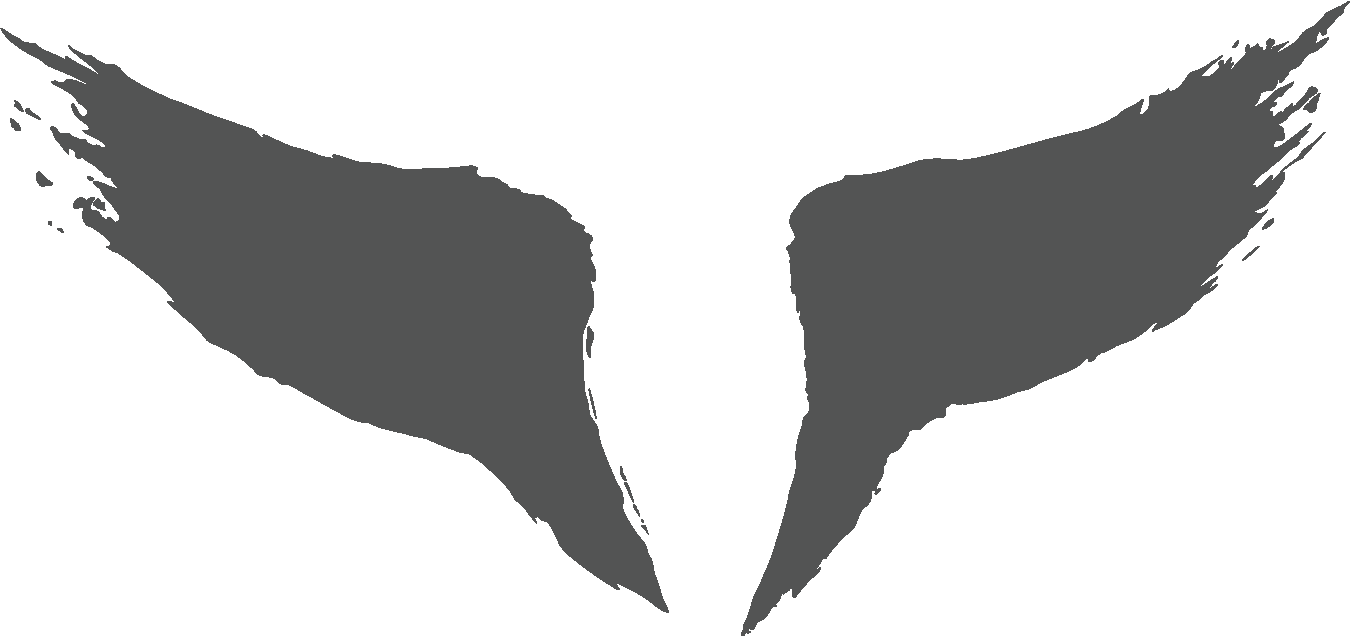
"Dare to keep up."
The Mardu are nomadic warriors who defend and expand their vast territory through a combination of agile tactics, superior technology, and identifying and exploiting the weaknesses of their opponents. They are known for their lightning-wielding fighters and archers, their strict and fierce commitment to their clan, their expert beastriders, and their unparalleled blacksmiths. The Mardu claim the central steppes and grassy plains of Tarkir as their territory, assembling massive mobile cities as they traverse the landscape.
Due to their centrally located territory, the Mardu establish treaties with other clans to protect trading caravans from dragons or other clans, taking a portion of the traded goods as payment. The nomadic Mardu can rapidly disseminate information across the plane, sending warnings to allies of oncoming threats, and staying ahead of their enemies' movements. They are incredibly defensive of their borders and consider those whom they do not have an agreement with as trespassing on their lands, disbanding them without hesitation.
Revival of the Mardu
With the constant traveling and war during Kolaghan's rule, the people struggled to keep their traditions and unity. Dissent and whispers of rebellion spread amongst the humanoids of the brood, but they remained isolated pockets for many years. During the Phyrexian invasion, Kolaghan's brood made up much of the frontline fighters, resulting in some of the heaviest losses of people and dragons of all the broods. Though they ultimately drove the Phyrexian invaders out, the war became the final push into chaos. Several rebel leaders raised the Mardu banner and started the open war against Kolaghan, not giving themselves or Kolaghan time to recover from the invasion.
Fractured and with small numbers, the Mardu knew they needed to rebuild and unify as a clan if they were to survive. The rebellion gathered members from across the plane, both those of Kolaghan's brood and members from other broods, growing over time into a formidable army—ultimately allowing the Mardu to defeat Kolaghan alongside the other dragonlords.
Mardu Dalkovans
The Mardu follow a highly organized military structure. As such, the lines between military and civilian life lack distinction within the clan. The Mardu see themselves as part of a whole, recognizing the importance of their individual contributions to the success of the clan. For all levels of rank, warriors have daily lives and domestic duties to support the clan. One might find that a hardened warrior is also an expert in beast training, sewing, or cooking. Even for those who are strictly civilian, there is an overall sense of comradery and military affiliation. For example, all young aspiring Mardu warriors participate in the Lightning Proving.
The Mardu are led by the khan, who is supported by a council of appointed generals called the Dalkovan Assembly. Each general leads their own subgroup of the Mardu called a dalkovan. Most of the appointed generals are former leaders in the rebellion against Kolaghan, venerated warriors from the Phyrexian invasion, and civilian elders pivotal to reestablishing order and teaching Mardu arts lost to Kolaghan's reign.
The Mardu have no permanent settlements, instead moving constantly across the plane in their dalkovans, able to erect massive, organized camp cities in less than a day. The Mardu have one main traveling party that is led by the khan, alongside smaller groups under their various generals. The small groups meet up with the main party periodically to trade supplies and information. Their travels are directed by the dragonstorms, weather, movements of other clans, and the whims of leadership. All members of the Mardu are expected to contribute to the movement and settlement of the clan.
The Mardu can train most any kind of animal and have a diverse array of creatures within their ranks. Much like with the people of the clans, mounts will often perform military and civilian functions: a creature may transport gear while the clan is on the move and later be armored and ridden into battle. Regardless, mounts in the Mardu are treated with care and respect and are viewed as integral to the clan.
Mardu Civilians and Military
Civilians
Though the lines between military and civilian life are often blurred in the Mardu, artisans, hunters, and healers don't participate in battle and instead specialize in a skill beneficial to the clan. The eldest within the Mardu are highly respected, and a number act as generals in the assembly, viewed as the collected wisdom of the clan that preserve their culture and traditions.
Blacksmiths are particularly revered not only for creating weapons but also their uncanny ability to break down, duplicate, and improve found technology. In addition, blacksmiths play an essential role in Mardu cultural practices, such as in the making tools for stormsingers, ceremonies, and celebrations. Mardu blacksmiths are renowned for their crafting of armor and weapons able to channel the latent energy of the dragonstorms that lingers in the plane.
Military Roles
There are three major roles within the Mardu army:
- Infantry – A smaller portion of the Mardu forces, composed of groups trained for specific situations, terrains, or combat objectives.
- Cavalry – A respected role in the Mardu ranks, and the bulk of their forces, composed of both light and heavy cavalry depending on the situation. Each warrior is an expert beastrider and trainer. The light cavalry typically attacks first and is then followed up by heavy cavalry to deliver the finishing blow.
- Siege engineers – The smallest subset of the Mardu force, requiring a unique combination of abilities. Siege engineers must be adept at using the technology but also able to control and manipulate the large structures.
Daily Life
- Hunting and trade – As a primarily nomadic group, the Mardu typically trade the spoils of their hunts, including meats, furs, and hides, in exchange for staple crops. Mardu technologies are also particularly valued among other clans, and though they closely guard their blacksmiths' finest works, they are willing to trade their technical knowledge and skills for materials that they do not have access to.
- Singing – People of the Mardu can be found sharing and creating new songs together. The Mardu have a collection of traditional songs for sending off the dead, marriage ceremonies, and luck for departing warriors or the sick. Mardu also practice their war shrieks, powerful songs to intimidate their foes and energize the troops.
- Painting and sculpting – The Mardu create large-scale murals and metal sculptures for both practical and aesthetic purposes. Structures decorate and enhance the beauty of their camps, and they can act as waystones in the vast steppe to guide the clan or mark spiritually significant areas.
- Sports – For the Mardu, sports are considered an essential combat-training tool because of their competitive, adaptive, and fast-thinking requirements. Of course, many accept sports as a convenient excuse for the fun and energy they bring to the clan. The three primary sports of the Mardu are:
- Beastriding – A contest of skill where riders perform a scripted series of tricks on beastback, normally judged by the leader of the camp.
- Archery – A series of escalating archery challenges, normally done with flaming or electrified arrows racing against other archers.
- Wrestling – A test of strength, agility, and coordination often done in teams to entertain cheering crowds.
Decree of Thunder
As a highly organized community, the Mardu follow strict cultural laws that dictate what is and is not allowed within the clan. As the original Edicts of Ilagra were lost to time, a new code was created after Kolaghan fell and the council swore allegiance to the new khan. The Decree of Thunder is composed of three primary tenets, which form the basis for all of their other laws:
- Loyalty is earned. Within the Mardu, actions speak the loudest. A leader must earn the respect of their troops, while a soldier must demonstrate their commitment to their fellows.
- Community is strength. Each person within the Mardu has their place in the greater whole, and the clan is only as strong as their most vulnerable, so they must protect and care for them.
- Victory is survival. A successful conquest is only a moment; as a clan, they must consider what comes next. Their greatest victory is the preservation of the clan for the future.
From these tenets, many further laws, as well as the punishments for breaking them, have been codified. While these laws can vary slightly between dalkovans, adherence to them is a key marker of being a member of the Mardu. Among these laws are rules of engagement and warfare, including the role of diplomacy in the Mardu. The Mardu will not invade a clan's territory without first sending a diplomat, and persons who surrender are treated with respect and offered a role with the clan.
Clash of Sky and Ember
The Mardu believe in the Emberheart and the Skybreath, two forces of nature representing the land and sky, exist in perpetual conflict. This clash of forces is manifested in sparks of lightning, raging storms, mighty winds, and geological upheavals. For the Mardu, these are forces that cannot be controlled but rather must be respected, and the pace of their nomadic lifestyle is designed to allow them to survive amidst these inexorable clashes of nature. The most powerful mages and stormsingers among the Mardu can draw upon the power of these colliding forces and, for short periods, manipulate them.
Overall, the Mardu have an open religious structure, mixing traditions and beliefs from other clans. Belief in the Clash of Sky and Ember exists alongside, and is often complementary to, practices brought in from other cultures.
Naming
The Mardu can have three names: a family name, a chosen name, and a given name. It is tradition to go by a family name until a Mardu comes of age, at which time they choose their own name after finishing the Lightning Proving. A given name is a special, third name given only by the khan to a warrior who has accomplished a feat in service of the clan and is named after it.
Great Assemblage
A celebration and competition that is held annually at the behest of the khan. All the Mardu come together to create a large feast, give gifts to one another, perform songs, and participate in or watch a tri-tier competition of all three Mardu sports. This is a time where those who have recently joined the Mardu are especially welcomed and taught Mardu traditions and where Mardu issue friendly challenges to their rivals.
Lightning Proving
In this ceremony, all the aspiring Mardu warriors who have come of age take a journey to a mountain peak to capture lightning during a storm. They bring it back as proof of their wit and ability to complete tasks for the clan. The exact nature of the Lightning Proving varies across dalkovans; some emphasize the young Mardu working as a team, while others are more competitive with a single winner earning higher status. The lightning is then used to spark a bonfire, and the Mardu eat and celebrate throughout the night. The participants are from then on called by their new chosen name.
Mardu Magic
Mardu magic primarily centers around manipulation of lightning and enhancing their physical abilities and weaponry, reflecting their commitment to strength and speed. Mages often use the specialized gear crafted by blacksmiths, though the most powerful mages can manipulate this energy directly. They can also spark flames and control other forms of raw elemental energy, often putting their skill to use in battle with other clans.
Mardu stormsingers are the clan's spiritual leaders and are often consulted for all sorts of matters both trivial and substantial. Stormsingers use sacred amulets to call the energies of the earth and sky into themselves and others. In battle, they support through empowering soldiers, weapons, and each other. Stormsingers also imbue their war shrieks with magical strength. Outside of battle, it is their duty to help protect Mardu camps, guide civilians, and lead ceremonies.
The Mardu's Relationship to Dragons and Dragonstorms
Dragon Hunts
The Mardu's unpredictable, fast nature and their history of keeping up with Kolaghan's brood make them reliable dragon hunters. As a central territory, they maintain constant vigilance across the steppe and will not hesitate to attack any dragons they discover. With their communications system, they can rapidly alert each other of potential threats.
Clan Dragons
Mardu dragons are treated as another part of the clan, and they are expected to contribute on and off the battlefield just like any other warrior. Dedicated trainers and sometimes a stormsinger care for the clan dragons. Mardu dragons tend to be fast and agile; the smaller dragons are often mounts for expert skyriders, while the larger dragon may aid in transport for Mardu troops and dalkovans. The Mardu will be relentless in their pursuit of capturing a dragon if it seems particularly strong or quick, sometimes dedicating months of their lives to it. Mardu dragons wield a lightning-breath weapon, shocking their enemies with their destructive capabilities.
Dragonstorms
The Mardu nomadic lifestyle allows them to stay ahead of dragonstorms, often chasing after them both to catch the wild dragons and for the rainfall that nourishes the steppe for their grazing herds. Their blacksmiths have also developed innovative lightning barriers that channel the energy of the dragonstorms into a swirling wall, keeping the camp inside relatively safe.
Locations
The majority of Mardu territory is in the central steppe of Tarkir, touching the borders of all the other clans. The climate is typically dry in summers with a short rainy season, and the steppe is dotted with rocky plateaus, swamps, chasms, and surrounding mountains.
- Dalkovan cities – Nomadic cities that can be broken down and built in hours. Dalkovans are often differentiated from each other by the name of their generals. As they are constantly on the move, many Mardu refer to their dalkovan simply as "home."
- Thunder Stadium – The central tent in the largest dalkovan city where Mardu congregate for market trade, play, eating, and other day-to-day activities. It is also where the main feasts for the Great Assemblage are held.
- Dragonsong Rock – A nickname for a long, circular rock formation that is used as a waypoint and vaguely resembles a dragon from above. It has been heavily painted and is regarded as a peaceful meeting point for diplomacy. Mardu like to sing here for the way it echoes their voices.
- Sandsteppe Gate – A former Abzan city that has since been captured by the Mardu. Remnants of the Abzan structures can be seen amongst the Mardu banners and tents. The region marks the transition from the Mardu steppe to more arid Abzan territory.
- Screamreach – A small system of bogs and swamps located near the intersection between Abzan, Mardu, and Sultai territory. The name is taken from the screeching ravens that dwell in the hollow trees.
- Goldengrave – A lowland grassy steppe that connects Screamreach to Sandsteppe. These rolling meadows form much of the Mardu territory. Large creatures roam this region, attracting dragons, and sudden storms are known to form frequently. The steppe is dotted with several permanent markers built by the Mardu as guideposts and refuges from storms. These are often also shrines marking the site of great battles and where Mardu and enemy dead are buried.
- The Scour – A deep chasm that passes through Mardu lands and into the Qal Sisma mountains in Temur lands. It's eroded by constant winds spiked with a fine black grit. Despite the danger, it's a great source for mining and ambush, and a frequent point of regional conflict.
The Temur 
"The land will guide us."
The Temur are a semi-nomadic people who thrive in the northern mountain terrain, living in concert with their environment. The Temur way of life is adapted to the long, freezing winters. They are expert hunters, gatherers, and herders, forming close bonds with animal companions that work alongside them. The revered Temur whisperers provide guidance and aid to the clan, calling upon the spirits of the land to augur the future. Largely isolationist, the Temur focus on protecting their lands and way of life from intrusion by other clans.
The Temur are stalwart in their defense of the northern regions, their warriors, hunters, and dragons maintaining patrols on their lands. They consider outsiders from other clans as a risk to the natural order and likely to pillage their scarce and precious resources. To the Temur, land protection and stewardship is integral to their way of life. They prioritize maintaining positive relationships with the spirits of the land and preserving natural resources for use by future generations. Some among the Temur also believe it is their responsibility to protect the lands of all Tarkir and have pushed for the clan to take a more active role outside of Temur territory.
Revival of the Temur
Resources were in perpetual decline under Atarka's rule. Starvation and illness were common among the people of the brood, and pockets of rebellion emerged over time as many sought ways to free themselves from the dragonlord's tyranny. At first, the people's rebellions remained small; they were focused on survival as the brood dragons now hunted them as prey. But many of the dragons had grown complacent, having not hunted for themselves in generations, and the rebels' knowledge of the terrain allowed them to effectively evade Atarka herself. The rebels saw the leadership of Atarka as cruel and greedy, resenting the insatiable gluttony of the dragons that stripped the land of its vitality.
As word of the smaller rebellions spread, many remaining whisperers emerged from hiding. They spoke of the Temur, of past traditions and the future they saw where they thrived once again as a people, galvanizing the rebellions. Led by formidable hunters, the rebels leveraged elemental magics and expert survival skills to fight back. They worked alongside the whisperers, who provided knowledge of the Unwritten Now to guide their next moves and stay ahead of Atarka's brood, and their combined might led to Atarka's defeat alongside the other dragonlords.
Temur Society
The Temur are semi-nomadic, transitioning during the year between villages and mobile camps. Winter, spring, and fall are generally spent in villages, while the summers are their most mobile time of year, as they move in more temporary camps to prevent overhunting or grazing in a single area.
The clan is led by the Dragonclaw and a head whisperer, the Twice Whisperer. The Dragonclaw is selected by the members of the Temur and is a revered warrior, while the Twice Whisperer is chosen by the spirits from among all the whisperers in the Temur. These two jointly make decisions that govern the entire clan, with the Dragonclaw primarily responsible for tangible matters and the Twice Whisperer governing spiritual and metaphysical affairs.
Beyond the overall clan leadership, the Temur consists of smaller, loosely connected family-based groups. The smaller, more fragmented nature of the clan is advantageous when defending against other clans and surviving in the resource-scarce climate. Family groups also follow the same two-leader structure, with lay and spiritual leadership working in tandem to make decisions for the group.
While many Temur are skilled in self-defense and hunting, within the clan, there are also highly trained warriors specialized in combat. Many of them work alongside mounts and animal companions that they use to cross vast, difficult terrain quickly and outmaneuver their opponents. They are experts at navigating harsh climates and can often avoid direct confrontations by using the environment against their enemies.
The Temur consider their animal companions to be part of their families and treat them with reverence and respect. Animal companions are bonded with a specific individual, living and working alongside them. The two can understand each other on a similar level as people, and most Temur will only have one animal companion at a time. Animal companions can be of many forms but are generally creatures suited to the role of their humanoid partners. Some companions may also work as mounts.
Daily Life
Civilians occupy many roles within the Temur. Hunters, gatherers, and herders are most common as direct supports to the wellbeing and lifestyle of the clan, focused on keeping them fed and sheltered. They are careful to ensure they maintain balance in the resources of the land, taking only what is needed and using all that they hunt or gather. Many of the hunters and gatherers also act as scouts, observing the changes in the region and activities of the other clans. Artists and craftspeople are highly respected within the clan.
- Wrestling – Athletic competitions are a frequent Temur pastime. Wrestling matches are one of the most common ways for warriors and hunters to stay prepared in the quieter seasons. Champion wrestlers are highly respected and often take leadership positions in the Temur.
- Hunting, horticulture, and animal husbandry – The northern climate is less hospitable to farming, so the Temur practice robust animal husbandry, bringing herds with them as they travel. They do some agriculture near their semi-permanent settlements and focus more on foraging and cultivation of what is already growing to maintain populations for future gathering. In addition, the Temur are proficient fishers, fishing from frozen lakes in the winter as an additional source of food in the coldest seasons.
- Storytelling – A major pastime within the Temur, often gathering as a community after a long hunt to celebrate and pass the long winter nights. Stories are often told through narrative dances and songs that dramatically reenact recent battles and hunts as well as traditional tales. These events can also become competitive, with storytellers vying to be the most entertaining.
- Sculpture and handcrafts – Given their semi-nomadic lifestyle, most Temur arts are small and portable. They specialize in embroidery and fine metalworking, crafting exquisite adornments that are easy to display and carry with them. Some artists, however, prefer to work on a grander scale, creating impressive temporary sculptures out of ice and other natural materials.
The Endless Song
The Temur believe in the Endless Song, the energy that suffuses the land and connects all beings past, present, and future. The core belief of the Endless Song is that spirits inhabit the land and exist alongside the corporeal world. Spirits are not bound by time and space in the same ways as mortal creatures are; they may exist in both the past and the future, and possibly even pasts that have never happened and futures that may never happen. The Temur view the Endless Song as a way of life rather than a practice or an obligation—the spirits are not something to be believed in; they simply exist.
Calling Ceremonies
Whisperers may lead ceremonies to call upon the spirits. Some are private rituals with only the whisperer, while others are larger events attended by many members of the clan. Ceremonies consist of a few common elements: singing of invocations combined with rhythmic music typically performed on a harp-like string instrument, specifically choreographed dances known only to the whisperer, and fires infused with magic allowing the whisperer to channel spirit energy to give it form if needed.
Seasonal Celebrations
Seasons dictate many of the Temur rituals. The transition to and from winter sets the cadence of the year and is marked with distinct ceremonies.
- Frostsweep – A somber celebration of the transition into fall. Temur families will gift food and other supplies to their community members, creating resources to help everyone get through the coming winter.
- Thawflow – A joyful celebration of the transition into spring, considered the Temur "new year" and often accompanied by a cleaning of homes and community spaces, clearing out old things and ushering in the new.
- The Unbroken Night – The longest night of the year celebrated with a feast accompanied by storytelling. Temur members will stay awake the entire night and day until the first glimpse of sun on the horizon marks the end of the endless night.
- The Zenith Day – The longest day of the year, celebrated with a day and night of dancing and gatherings, often including various competitions and boisterous activities that only pause as they gather to watch the sun dip below the horizon.
Temur Magic
Temur magic primarily revolves around the channeling of elemental energies by mages to empower and defend the clan. Mages in the Temur can directly animate the land and natural objects, imbuing them with elemental energy and creating a tangible force that they can direct for a specific task. Temur magic often takes the shape of animals familiar or important to the caster.
Whisperers are chosen as representatives of the land by the spirits and are directly connected to the Endless Song. As such, whisperers are highly revered and important members of the Temur. Whisperers are most often chosen in young adulthood and undergo rigorous training alongside an existing whisperer to hone their magics and master their abilities. Whisperers are deeply integrated into their communities; they do not participate in hunts or combat but provide healing, protection, and divination to aid their fellows. Temur will regularly entreat whisperers for guidance and help, and interactions with them are a frequent part of daily life.
The Temur's Relationship to Dragons and Dragonstorms
Dragon Hunts
Temur whisperers are experts at predicting the timing and locations of upcoming dragonstorms. This allows the Temur to arrive at a storm before most other clans and to bring into their fold more of the newly formed wild dragons.
Clan Dragons
The Temur form strong bonds with dragons, who train alongside warriors and hunters of the clan, primarily assisting in these activities like other members of the Temur. Dragons in the Temur tend to congregate into small, family-like groups. As some of the most powerful and feared clan dragons, they defend the perimeters of Temur lands and are fiercely protective of the members of the clan. They are generally stocky and robust dragons that wield fire as a breath weapon to incinerate their enemies, helping them to better thrive in the northern regions.
Dragonstorms
Temur whisperers can predict the timing and location of most dragonstorms on the plane. This knowledge, combined with their semi-nomadic lifestyle, allows the Temur to quickly vacate a region or shelter against the storms. Elemental magic experts are also able to manipulate the storms to protect the clan, generating barriers of snow and rain to ward off the worst of the weather.
Locations
Most of the Temur lands are in the snowy, craggy Qal Sima mountain range and foothills. Temur land borders directly with the Mardu and Jeskai. The climate is subarctic, with freezing temperatures and much of the landscape covered in snow for most of the year. Summers are short and verdant.
- Karakyk Glacial Settlement – Located within a glacial valley, the village is one of the two mostly permanent locations of the Temur that is primarily occupied through the winter months. Carved ice caverns provide comfort and insulation, with openings made from treated leather and dragon bone.
- Summer Landing – An alpine forest clearing located in the foothills, formally known as Ayagor (or "dragon bowl"). The site has been reclaimed by the Temur and is used for the annual observation of the Zenith Day, where they celebrate their continued survival as a clan and commemorate those lost to Atarka's cruelty.
- Mistrise Village – A semi-permanent settlement built around geothermal steam vents that are used to heat homes as the seasons change. The vents are most active in the spring and fall, causing an influx of Temur families to come to the village during those months.
- Eternal Ice – A holy sacred mountain peak with a mountain snowfield that is solid and stable. It is a place traversed only by whisperers and contains a special site for important whisperer ceremonies.
- Qadat, the Fire Rim – Located between Jeskai and Temur lands, formally belonging to the Jeskai and later conquered by Atarka. Currently there is a tentative accord, allowing either clan to hunt and gather in the region, but no settlements may be built there. The region is known for its volcanic activity.
- The Dragon's Throat – A high, winding valley where the natural acoustics have created a continuous wail. This is a sacred location visited only by whisperers.
- Glintglaze Lake – An alpine lake that freezes over in winter but remains an abundant source of fish all year. The ice is dense enough in winter that Temur will camp on its surface.
- Rainveil Forest – A verdant forest that covers much of the lower mountains, this region is frequented by the Temur during the summer when the flora and fauna are most abundant.
You've met the clans, now get ready for the epic seven-part story when it kicks off on March 3. You'll be able to read along right here on DailyMTG or tune in with The Magic Story Podcast.
Ready to brave the storm? Tarkir: Dragonstorm releases on April 11, 2025, and is available for preorder now from local game store, online retailers like Amazon, and elsewhere Magic products are sold.





